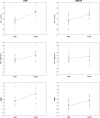Right ventricular mechanics and contractility after aortic valve replacement surgery: a randomised study comparing minimally invasive versus conventional approach
- PMID: 30057770
- PMCID: PMC6059303
- DOI: 10.1136/openhrt-2018-000842
Right ventricular mechanics and contractility after aortic valve replacement surgery: a randomised study comparing minimally invasive versus conventional approach
Abstract
Objective: Minimally invasive aortic valve replacementsurgery (MIAVR) is an alternative surgical technique to conventional aortic valve replacement surgery (AVR) in selected patients. The randomised study Cardiac Function after Minimally Invasive Aortic Valve Implantation (CMILE) showed that right ventricular (RV) longitudinal function was reduced after both MIAVR and AVR, but the reduction was more pronounced following AVR. However, postoperative global RV function was equally impaired in both groups. The purpose of this study was to explore alterations in RV mechanics and contractility following MIAVR as compared with AVR.
Methods: A predefined post hoc analysis of CMILE consisting of 40 patients with severe aortic valve stenosis who were eligible for isolated surgical aortic valve replacement were randomised to MIAVR or AVR. RV function was assessed by echocardiography prior to surgery and 40 days post-surgery.
Results: Comparing preoperative to postoperative values, RV longitudinal strain rate was preserved following MIAVR (-1.5±0.5 vs -1.5±0.4 1/s, p=0.84) but declined following AVR (-1.7±0.3 vs -1.4±0.3 1/s, p<0.01). RV longitudinal strain reduced following AVR (-27.4±2.9% vs -18.8%±4.7%, p<0.001) and MIAVR (-26.5±5.3% vs -20.7%±4.5%, p<0.01). Peak systolic velocity of the lateral tricuspid annulus reduced by 36.6% in the AVR group (9.3±2.1 vs 5.9±1.5 cm/s, p<0.01) and 18.8% in the MIAVR group (10.1±2.9 vs 8.2±1.4 cm/s, p<0.01) when comparing preoperative values with postoperative values.
Conclusions: RV contractility was preserved following MIAVR but was deteriorated following AVR. RV longitudinal function reduced substantially following AVR. A decline in RV longitudinal function was also observed following MIAVR, however, to a much lesser extent.
Keywords: aortic valve disease; cardiac function; echocardiography; minimally invasive; surgery-valve.
Conflict of interest statement
Competing interests: None declared.
Figures



Similar articles
-
Propensity matched analysis of minimally invasive versus conventional isolated aortic valve replacement.Perfusion. 2023 Mar;38(2):261-269. doi: 10.1177/02676591211045802. Epub 2021 Sep 13. Perfusion. 2023. PMID: 34515578 Free PMC article.
-
Preoperative planning of left-sided valve surgery with 3D computed tomography reconstruction models: sternotomy or a minimally invasive approach?Interact Cardiovasc Thorac Surg. 2016 May;22(5):587-93. doi: 10.1093/icvts/ivv408. Epub 2016 Jan 29. Interact Cardiovasc Thorac Surg. 2016. PMID: 26826714 Free PMC article.
-
Impact of transcatheter aortic valve implantation or surgical aortic valve replacement on right ventricular function.Heart. 2012 Sep;98(17):1299-304. doi: 10.1136/heartjnl-2011-301203. Epub 2012 Jun 11. Heart. 2012. PMID: 22689711
-
Minimally invasive aortic valve surgery: state of the art and future directions.Ann Cardiothorac Surg. 2015 Jan;4(1):26-32. doi: 10.3978/j.issn.2225-319X.2015.01.01. Ann Cardiothorac Surg. 2015. PMID: 25694973 Free PMC article. Review.
-
Latent myopathy is more pronounced in patients with low flow versus normal flow aortic stenosis with normal left ventricular ejection fraction who are undergoing surgical aortic valve replacement: Multicenter study with a brief review of the literature.Echocardiography. 2018 May;35(5):611-620. doi: 10.1111/echo.13839. Epub 2018 Apr 1. Echocardiography. 2018. PMID: 29605969 Review.
Cited by
-
Upper Hemi-Sternotomy Provides Benefit for Patients with Isolated or Combined Mitral Valve Surgery.Medicina (Kaunas). 2022 Jan 18;58(2):142. doi: 10.3390/medicina58020142. Medicina (Kaunas). 2022. PMID: 35208468 Free PMC article.
-
Characterization of biventricular alterations in myocardial (reverse) remodelling in aortic banding-induced chronic pressure overload.Sci Rep. 2019 Feb 27;9(1):2956. doi: 10.1038/s41598-019-39581-9. Sci Rep. 2019. PMID: 30814653 Free PMC article.
-
Right Ventricular Dysfunction before and after Cardiac Surgery: Prognostic Implications.J Clin Med. 2024 Mar 11;13(6):1609. doi: 10.3390/jcm13061609. J Clin Med. 2024. PMID: 38541835 Free PMC article. Review.
-
Limited versus full sternotomy for aortic valve replacement.Cochrane Database Syst Rev. 2023 Dec 6;12(12):CD011793. doi: 10.1002/14651858.CD011793.pub3. Cochrane Database Syst Rev. 2023. PMID: 38054555 Free PMC article.
-
Baseline characteristics and 1-year outcome by left ventricular function in the CABG PREFERS.Eur Heart J Open. 2025 Mar 5;5(2):oeaf014. doi: 10.1093/ehjopen/oeaf014. eCollection 2025 Mar. Eur Heart J Open. 2025. PMID: 40177505 Free PMC article.
References
-
- Unsworth B, Casula RP, Yadav H, et al. . Contrasting effect of different cardiothoracic operations on echocardiographic right ventricular long axis velocities, and implications for interpretation of post-operative values. Int J Cardiol 2013;165:151–60. 10.1016/j.ijcard.2011.08.031 - DOI - PMC - PubMed
Publication types
LinkOut - more resources
Full Text Sources
Other Literature Sources
